The best Portuguese desserts (and where to try them in Lisbon)

If we were to ask international visitors who come to Portugal what their favorite Portuguese dessert is, chances are many would say pastel de nata. The thing is that, in our country, Portuguese custard tarts aren’t considered a dessert, but instead a pastry to be enjoyed at breakfast or with a coffee any time of the day.
For the Portuguese, the cakes which you find at our usual pastelarias, that is pastry shops and cafés, are distinct from those you’d eat after a meal. Unless it’s a contemporary reinvention of our custard tarts, like the pastel de nata mille feuille by chef José Avillez served at Páteo do Bairro do Avillez, you shall not find such pastries at a restaurant. Custard tarts, bean tarts, rice muffins, chocolate salami and sweets of the sort are typical Portuguese cakes and pastries to enjoy any time of the day – but usually not so much after a meal.
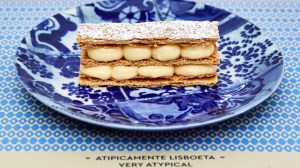
At restaurants, the Portuguese sweets repertoire includes a vast range of desserts, which do tend to vary a little depending on the region of the country.
We share with you the most common typical Portuguese desserts you will find in restaurants across Portugal, and the best places to try them in Lisbon:
Pudim Abade de Priscos
Arguably the most decadent of all Portuguese desserts, this pudding named after the Abbot of Priscos in the northern city of Braga, where the recipe was developed, is a bomb of a dessert! Perhaps the most velvety pudding you ought to find in Portugal, pudim Abade de Priscos is prepared with copious amounts of egg yolks, sugar and bacon (yes, you read that right), flavored with lemon zest, cinnamon and Port wine. If you’re feeling rather full after your meal but still feel like eating dessert, it may be a good idea to split this one, as it’s as heavy as they come!
Where to try pudim Abade de Priscos in Lisbon:
O Galito
📍Rua Adelaide Cabete 7, 1500-441 Lisbon
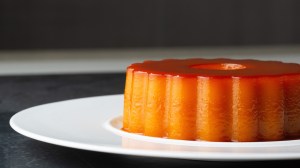
Pudim de ovos | Pudim flan
Pudim de ovos. Pudim flan. Pudim de gemas. These are some of the names that may refer to a dessert similar to crème caramel here in Portugal. This is a popular puding not only in our country, but a little all over southern Europe and the wider world, specially in hispanic and Spanish influenced countries. It consists of a semi-hard milk and eggs custard usually cooked in a bain-marie, drenched with caramel sauce. In Portugal, pudim de gemas stands for a flan which is particularly heavy in egg yolks (in Portuguese gemas), thus appearing a little yellower than other international versions of this dessert.
Where to try pudim de ovos in Lisbon:
O Minhoto
📍Tv. da Boa Hora 21, 1200-063 Lisbon
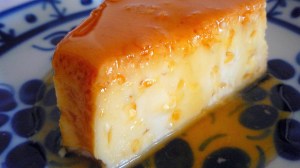
Leite creme
Just like flan above, leite creme isn’t a 100% Portuguese dessert. Related to crème brûlée from France, Trinity cream from the UK, and crema Catalana from Spain, leite creme is Portugal’s take on milk custard. It is usually served in an individual clay bowl as seen here and covered with a layer of sugar. When you see leite creme on restaurant dessert counters, it may not feature a crispy top yet. In a good place, the sugar will be burnt on the spot, perhaps even at your table, using a torch responsible for caramelizing the sugar and turning it into a crispy candied surface. Breaking the crystallized sugar with your spoon before digging into the creamy leite creme below is one of those rare inexplicable pleasures, like bursting bubble wrap.
Where to try leite creme in Lisbon:
Cardoso do Estrela de Douro
📍Rua da Graça 24, 1170-270 Lisbon
www.facebook.com/CardosoDaGraca
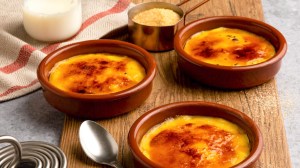
Farófias
Poached meringues are an unassuming Portuguese dessert that, when done right, are one of the fluffiest things your palate can come in contact with. Sweet and delicate, farófias consist of meringues prepared with egg whites, which are poached in sweet milk. They can be served on a base of custard, sometimes also used as a topping, and thus are sometimes also referred to as farófias com leite creme. Farófias are a Portuguese adaptation of the French recipe île flottante (floating island), which also features poached meringues served atop creme anglaise. The main difference between the French and Portuguese versions has to do with the use of vanilla, which is an ingredient that is rarely featured in traditional Portuguese cooking.
Where to try farófias in Lisbon:
A Tasquinha do Lagarto
📍Rua de Campolide 258, 1070-039 Lisbon
www.facebook.com/tasquinhadolagarto

Toucinho do céu
Bacon from heaven – this is what the name of this dessert translates as! Toucinho do céu is a typical dessert from the Alentejo and, back in the day, it was prepared with pork lard, an ingredient abundant in a region that has pork as one of its main diet staples. Nowadays it is more often prepared with butter, but the other essential elements of toucinho do céu, which are almonds and eggs, remain the same. Portuguese toucinho do céu is not to be mistaken with Spanish tocino de cielo. While the Spanish version is closer to an egg yolk pudding, meant to be spooned, Portuguese toucinho do céu is a drier cake which you can slice, and which has a distinct almond meal flavor. Like many of the best Portuguese desserts, “bacon from heaven” was developed by nuns, in this case in the monastery of Murça, in the northern city of Vila Real of Trás-os-Montes.
Where to try toucinho do céu in Lisbon:
Casa do Alentejo
📍Rua das Portas de Santo Antão 58, 1150-268 Lisbon

Serradura
Serradura, or sawdust pudding, is a very straightforward dessert which consists of layers of whipped cream and condensed milk, and crumbled Marie tea biscuit, which explains the name. Serradura is a pudding usually served inside individual glass bowls, meant to be eaten by the spoonful. Recipe wise, serradura is as easy as they come, and it may be a quick one to whip up at home if you’re feeling like having something sweet with Portuguese essence. Serradura is popular not only in Portugal but also Macao, a former Portuguese colony, where it’s sometimes known as Macao pudding and may include variations of flavors, featuring chocolate, oreo, green tea or other add-ons.
Where to try serradura in Lisbon:
Grelha dos Sabores
📍Av. João Paulo II 526, 1950-159 Lisbon
www.facebook.com/Grelha-dos-sabores-1746541278979506
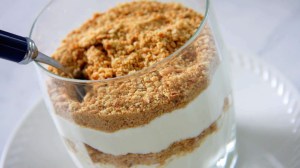
Baba de camelo
“Camel’s drool” may not sound appealing when you think of something to eat. But that’s only if you’ve never tried baba de camelo. If you’re into all things really sweet, this caramel mousse may be a good option for you! Reminiscent of latinamerican dulce de leche, the preparation of baba de camelo brings together condensed milk and egg whites beaten to a stiff peak, responsible for the mousse type of consistency of this dessert. Whenever you come across a Portuguese dessert with dairy, you’re safe to assume that this is a more contemporary recipe. And that is indeed the case of baba de camelo, which is believed to have originated when a lady had impromptu guests at home and, without many ingredients or time at hand, ended up whipping this quick dessert which became a favorite in a country where we have quite a pronounced sweet tooth!
Where to try baba de camelo in Lisbon:
Laurentina Rei do Bacalhau
📍Av. Conde Valbom 71A, 1050-067 Lisbon
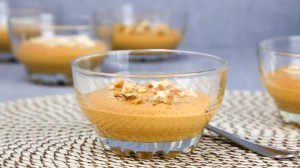
Mousse de chocolate
We’re not here to argue that chocolate mousse is a Portuguese dessert. Of course it’s not exclusive to our country but, the truth is that here in Portugal mousse de chocolate is prepared in a pretty specific way. While many may associate a certain level of sponginess to a high quality chocolate mousse, in Portugal, this chocolate dessert is often closer to a caramel type of consistency. Moderately dark, very sweet and rich, Portuguese chocolate mousse certainly is an experience chocolate lovers should embark on! As you will quickly notice eating out and about in Lisbon and the rest of Portugal, this is one of the most common desserts you’ll come across in Portuguese restaurant menus, particularly tascas and other day to day eateries.
Where to try chocolate mousse in Lisbon:
Pap’Açôrda
📍Time Out Market, Av. 24 de Julho 49, 1200-479 Lisbon
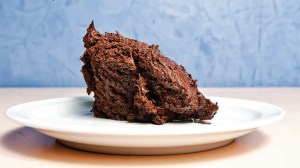
Bolo de bolacha
Coffee lovers rejoice, as bolo de bolacha may just become your favorite Portuguese dessert. Biscuit cake is a layered confection which consists of a tower built with coffee soaked Marie biscuits and buttercream acting as cement in between tiers. The top coating is done with buttercream and it’s common to do a flower shaped cake with the round biscuits placed in a circle with a tower of the same in the middle. Portuguese bolo de bolacha is most commonly garnished with crushed biscuits or few coffee beans, but it can also be taken to the next level with a syrupy egg jam, known locally as doce de ovos.
Where to try bolo de bolacha in Lisbon:
Nós é Mais Bolos
📍Time Out Market, Av. 24 de Julho 49, 1200-479 Lisbon
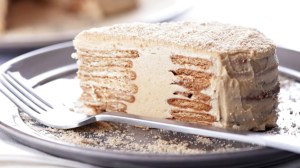
Doce da casa | Natas do céu
Doce da casa, or “the house’s dessert” is a curious example of Portuguese present-day pudding making. Even though you’d expect that each house or establishment will have its own speciality dessert, the name doce da casa stands for a pretty stereotypical pudding prepared with a bottom layer of eggs and condensed milk custard, crushed biscuits and and top of whipped cream. Doce da casa, which is in reality almost the same dessert as natas do céu, or cream from heaven, may have one single layer of each component, or several floors. While doce da casa is usually decorated with chocolate shavings which stand out on top of the whipped cream, natas do céu focuses on the layers of whipped cream forsaking the condensed milk, and instead finishing the top layer with sugary egg jam.
Where to try doce da casa in Lisbon:
Cervejaria Trindade
📍Rua Nova da Trindade 20 C, 1200-303 Lisbon
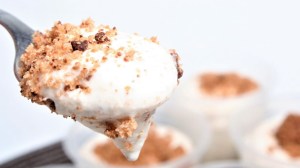
Molotof
When you start eating desserts in Portugal, you’ll quickly notice how most of them are yellow. This is because we are mildly obsessed with egg yolks, the backbone of Portuguese conventual desserts. But the question soon arises: what happens to all the egg whites which are leftover? Don’t worry as they are not discarded. Instead they are turned into other desserts such as farófias above, and molotof. Also known as molotov or pudim molotof, this is an egg whites flan, which is as airy and fluffy as they come. Molotof can be topped with caramel sauce or egg jam, thus messing once again with the balanced use of egg yolks and whites. This dessert’s blunt name evolved from Malakoff and is related to the Crimea war of the 1850s, when there was a shortage of ingredients and something similar was prepared using egg whites and sugar.
Where to try molotof in Lisbon:
Os Compadres
📍Estr. Desvio 28, 1750-099 Lisbon
https://restauranteoscompadres.net
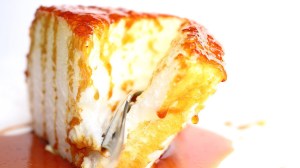
Arroz doce
Many regions of the world have their own version of sweet rice pudding. In Portugal, arroz doce stands out as less creamy than in other countries, perhaps a little denser than most, and definitely yellower. Why? You guessed it right: because of the addition of a considerable amount of egg yolks! The rice is cooked in sweetened milk, infused with lemon zest and cinnamon. A serving of arroz doce is customarily decorated with ground cinnamon on top, often in festive shapes. Even though you can find arroz doce all over Portugal, it is traditionally associated with the north of the country, particularly with the Minho region, where it was for a long time served during popular festivals and weddings.
Where to try arroz doce in Lisbon:
Adega da Tia Matilde
📍Rua da Beneficência 77, 1600-017 Lisbon
www.facebook.com/restaurante.adegatiamatilde
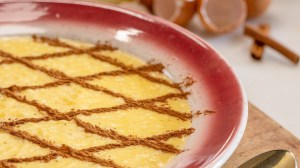
Sericaia
Sericaia is, beyond a doubt, Alentejo’s most popular dessert. Also known as sericá, this dessert features a consistency somewhere between a cake and a pudding. It’s prepared with milk, eggs, sugar and only a little flour, which is flavored with lots of cinnamon. Sericaia is cooked in a fairly shallow clay vessel designed specifically for this dessert, and it’s topped with lots of ground cinnamon. Once in the oven, it’s normal for the top layer of sericaia to crack and appear wrinkled. A genuine serving of sericaia will include a slice of this cake along with a candied plum from the Alentejo city of Elvas, preserved in sugar syrup. The popularization of sericaia in Portugal dates back to the Age of Explorations. It is believed that Constantino de Bragança, who was a governor of Goa when this part of India was a Portuguese colony, brought the recipe into Portugal in the 16th century. Even though sericaia was back then cooked inside wood ovens, it is now-a-days prepared in regular kitchens, in Alentejo and all over Portugal.
Where to try sericaia in Lisbon:
Solar dos Nunes
📍Rua dos Lusíadas 68, 1300-366 Lisbon
www.facebook.com/restaurantesolardosnunes
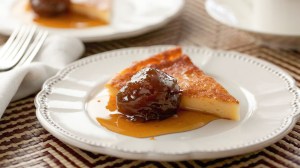
Tigelada
Here’s another dessert to prove that Portugal sure loves custard in all its shapes and forms. Tigelada is a coarse custard cooked inside a preheated glazed clay bowl developed for the making of this dessert, and it’s typical from the city of Abrantes. As such, it often also goes by the name tigelada de Abrantes. It consists of a milk custard, with sugar and eggs, thickened with flour. Its top layer it’s meant to get caramelized and fairly dark. This rustic dessert is prepared in big bowls and spooned onto a plate at restaurants, but it’s also common to find individual tigeladas in pastelarias all over Portugal.
Where to try tigelada in Lisbon:
Drogaria
📍Rua Joaquim Casimiro 8, 1200-696 Lisbon

Torta de laranja
Portuguese style orange torte is an ancient recipe, simple and very aromatic. Torta de laranja has been typical in the southern area of Portugal since the 16th century. History records can’t set the controversy straight, so we can’t tell for sure if the confection originated in Lagos, in the Algarve, or Setúbal, where you also find the look-alike torta de Azeitão, which is also a yellow roll, but does not contain citrus. This is one of the rare Portuguese desserts featuring fruits, so if you’re into refreshing tastes, it may be a good option to end your typical Portuguese meal!
Where to try orange torte in Lisbon:
Casa dos Ovos Moles em Lisboa
📍Calçada do Sacramento 25, 1200-393 Lisbon
www.casadosovosmolesemlisboa.pt
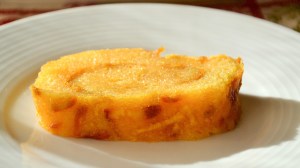
Morgado do Bussaco
The name morgado stands for several distinct desserts in Portugal. Morgado de amêndoa and morgado de figo, from the Algarve, are prepared with almonds and dried figs respectively. Morgado do Bussaco is a recipe which was developed in the area of Bairrada, a region known for other delicacies such as spit-roasted suckling pig and Bairrada style wines. Morgado do Bussaco consists of a layer of giant kind of pancakes prepared with egg whites, walnuts and sweeteners like sugar and honey, which are interleaved with ovos moles from Aveiro, a thick cooked egg yolk and sugar confection. The top layer of morgado do Bussaco is enriched with walnuts, for added crunch. A delectable experience which is not as common as other deserts featured in this article, like arroz doce, leite creme or pudim de ovos, but if you come across it, we recommend making the most of the opportunity!
Where to try morgado do Bussaco in Lisbon:
Fama d’Alfama
📍Rua do Terreiro do Trigo 80, 1100-604 Lisbon
www.facebook.com/restaurantefamadalfama
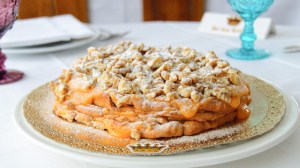
Encharcada
Also known as encharcada de ovos, this is another example of Alentejo style dessert, rich in sugar, egg yolks and history. Like most Portuguese conventual desserts, encharcada’s origins date as far back as the 15th century, when spices like cinnamon started to enter the Portuguese market coming from Asia. Encharcada consists of egg yolks and a gaudy amount of sugar cooked with a little lemon zest infused water which soon turns into syrup. Encharcada, which translates as “drenched” is a moist dessert topped with ground cinnamon for serving. Once again, not exactly a light option, but a delectable experience which also goes to prove how much the Portuguese can do with egg yolks and sugar – an incredible variety!
Where to try encharcada in Lisbon:
Salsa & Coentros
📍Rua Cel. Marques Leitão 12, 1700-337 Lisbon
https://restaurantesalsaecoentros.pt
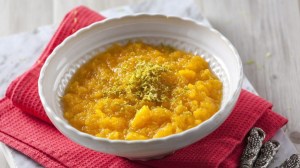
Other Portuguese conventual sweets
The collection of Portuguese conventual sweets features so many other options! Some are enjoyed as a snack any time of the day, perhaps with a coffee (like pastel de Tentúgal, sweet bean tarts, brisas do Liz, bom bocado or cornucópias), while others are indeed regarded as having dessert qualities. In this latter category we could include fios de ovos, trouxas de ovos, pão de rala, papos de anjo, and many more. Learn about the most typical Portuguese sweets developed in convents and realize that you’ll never have enough time to try all the conventual sweets from regions across Portugal, as the list seems to be never ending!
Where to try doces conventuais in Lisbon:
Alcôa
📍Rua Garrett 37, 1200-203 Lisbon

Rabanadas
Even though rabanadas are, alongside bolo rei, considered the most iconic Christmas dessert in Portugal, they are now-a-days also enjoyed during other occasions. Some contemporary Portuguese restaurants have been featuring rabanadas, Portugal’s take on French toast or pain perdu, in elevated ways. Regular rabanadas consist of thick country style bread slices soaked in milk and egg, fried and coated with cinnamon sugar. More modern versions include add-ons such as custard, different sauces and also distinct breads and cuts of it. The humble rabanada has been living a true revolution in modern Portuguese cuisine, and we think that it’s due time that we can enjoy this dessert also known as golden slice (fatias douradas) anytime besides Christmas!
Where to try rabanadas in Lisbon:
Plano
📍Rua da Bela Vista à Graça 126, 1170-055 Lisbon
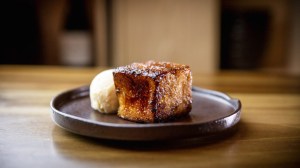
Other Portuguese Christmas desserts
Besides rabanadas, there are many other desserts which are typically found around Christmas, including aletria (milk and angel hair pasta pudding), mexidos or formigos (a scrambled prepared with bread, nuts, honey, Port wine and raisins, typical from Minho), lampreia de fios de ovos (syrupy egg threads shaped as a lamprey) and sweet dough fritters like sonhos, azevias, coscorões and filhós, which are also known as filhoses. Some of these may make it to restaurant menus during this festive time of the year, while bolo rei, bolo rainha and the Christmas fritters are sold in virtually any pastelaria in the country. But, generally speaking, most of them are prepared by families and enjoyed at home. If you visit Portugal around Christmas time, we hope you get lucky to be invited to someone’s home and you have the chance to experience the sweetest side of Portuguese culture behind closed doors.
Where to try Portuguese Christmas sweets in Lisbon:
Confeitaria Nacional
📍Praça da Figueira 18B, 1100-241 Lisbon
https://confeitarianacional.com
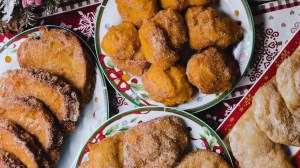
Are you ready for a sugar high? Travel to Lisbon and let us know via Instagram what Portuguese desserts you like the most! We’ll love to see your photo shoots, to know about your insights, questions, suggestions and wishes on your food & culture experiences in Lisbon and Portugal. Please share with us via Instagram Facebook,or Twitter and tag us @tasteoflisboa or #tasteoflisboa.
Feed your curiosity on Portuguese food culture:
The world of Portuguese conventual sweets
How to identify the perfect Portuguese custard tart
Where to eat the best Portuguese custard tarts in Lisbon
10 pastries you should eat in Portugal (besides custard tart)
Real people, real food. Come with us to where the locals go.
Signup for our natively curated food & cultural experiences.
Follow us for more at Instagram, Twitter e Youtube
